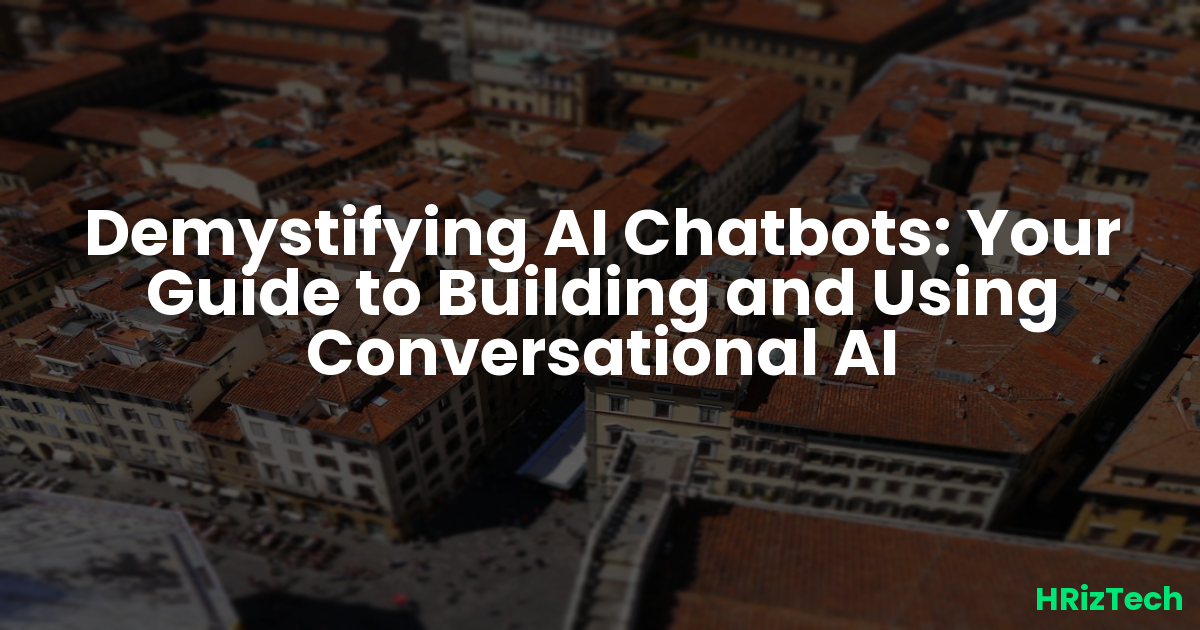Demystifying AI Chatbots: Your Guide to Building and Using Conversational AI

Demystifying AI Chatbots: Your Guide to Building and Using Conversational AI
Ever wondered how those helpful chatbots on websites seem to understand your questions so well? It's all thanks to the magic of Artificial Intelligence (AI), specifically, the rapidly growing field of chatbot development. This isn't just futuristic tech; it's shaping the future of jobs and AI careers right now, creating exciting opportunities for skilled professionals. Ready to dive in and discover how you can build your own?
Why AI Chatbots Matter in the Future of Work
AI chatbots are no longer a novelty. They're transforming customer service, streamlining internal communication, and even assisting with complex tasks. A 2025 Gartner report predicts that AI-powered chatbots will handle 80% of customer service interactions. This means increased efficiency, reduced costs, and a 24/7 availability for businesses. But it also means a huge demand for individuals who understand how to design, build, and maintain these essential digital assistants. This is where the future jobs and AI careers come into play.
Step-by-Step Guide: How to Start Building an AI Chatbot
Building an AI chatbot might sound daunting, but it's more accessible than you think. There are several platforms and tools that simplify the process, even for beginners. Let’s break it down into manageable steps:
- Choose your platform: Several no-code/low-code platforms like Dialogflow (Google Cloud), Amazon Lex, or Microsoft Bot Framework allow you to create chatbots without extensive coding knowledge. These are great starting points for learning the basics of chatbot development.
- Define your chatbot's purpose: What tasks will your chatbot perform? Customer service? Lead generation? Internal support? A clear objective guides your design and ensures the chatbot is effective.
- Design the conversation flow: Map out the typical interactions a user might have with your chatbot. Consider various scenarios and user inputs. Think about how to handle unexpected questions or errors gracefully.
- Develop and test your chatbot: Use your chosen platform to build the chatbot, incorporating your conversation flow and any necessary integrations with other systems (e.g., databases, CRM).
- Deploy and monitor: Once you're happy with your chatbot, deploy it to your website or app. Continuously monitor its performance, gather user feedback, and make improvements based on real-world interactions. Regular updates are crucial for keeping your chatbot relevant and effective.
Essential AI Tools for Chatbot Development
Beyond the platforms mentioned above, several other tools can significantly enhance your chatbot development process. These include tools for natural language processing (NLP), machine learning (ML) model training, and chatbot analytics.
- Rasa: An open-source framework for building conversational AI assistants.
- TensorFlow and PyTorch: Powerful machine learning libraries for building custom NLP models if you're comfortable with coding.
- Chatfuel: A user-friendly platform for creating chatbots on Facebook Messenger.
Common Mistakes to Avoid in Chatbot Creation
Even experienced developers make mistakes. Avoid these common pitfalls to ensure your chatbot is effective and user-friendly:
- Ignoring user experience (UX): A poorly designed chatbot is frustrating to use. Prioritize intuitive navigation and clear communication.
- Not planning for unexpected input: Users won't always type exactly what you anticipate. Build in error handling and fallback mechanisms.
- Failing to test thoroughly: Thorough testing is crucial for identifying and fixing bugs before your chatbot goes live.
Looking Ahead: AI Chatbots in 2025 and Beyond
The future of AI chatbots is bright. By 2025, we'll likely see even more sophisticated chatbots capable of handling increasingly complex tasks. Advances in natural language processing will allow for more natural and human-like conversations. However, we also need to consider the ethical implications and potential cybersecurity threats associated with AI. Protecting user data and preventing malicious use will be crucial. Have you considered the security aspects of your chatbot development?
The demand for skilled chatbot developers and AI specialists will continue to grow, offering exciting career paths for those willing to learn and adapt. The integration of AI chatbots with other technologies, like the metaverse, will open up entirely new avenues for innovation.
So, what are you waiting for? Start exploring the world of AI chatbots today! Check out our guide on Python basics here to get started with coding, or learn more about the ethical considerations of AI here. Learning about machine learning here can also significantly boost your skills.
What’s your favorite AI tool? Let us know below! Share this post with anyone interested in the future of work and AI careers!
Comments
No comments yet. Be the first to comment!